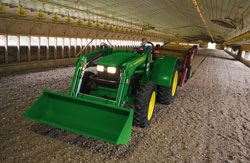
John Deere Introduces New 105-HP Poultry Tractor
LENEXA, Kansas — John Deere introduces the 5105ML Tractor — specifically configured for poultry producers who need a low-profile loader tractor.
"The 5105ML is extremely versatile and reliable and it's compatible with a John Deere 553 or 563 Loader. Thanks to its low profile, customers can easily operate it inside the confines of most poultry houses. It has plenty of hitch-lift capacity and at 7,700 pounds the 5105ML has the weight to provide added stability to pull poultry-house cleaners. The mounting surface of the loader frame is perpendicular so weight is transferred to the tractor in a more efficient manner. With this type of loader integration and an 18.4-gpm hydraulic flow, operators can load quickly and efficiently when cleaning poultry houses. You won't find a tractor that works harder or that's more capable in its class," says Owen Frederic, John Deere product marketing manager.
 The heart of the 5105ML is a reliable John Deere PowerTech™ four-cylinder diesel engine that produces up to 105 engine horsepower (90 PTO hp). Customers can choose from two transmission options for the 5105ML to tailor it to best fit their operation. The transmission options are:
The heart of the 5105ML is a reliable John Deere PowerTech™ four-cylinder diesel engine that produces up to 105 engine horsepower (90 PTO hp). Customers can choose from two transmission options for the 5105ML to tailor it to best fit their operation. The transmission options are:
12/F/4R SyncShuttle Plus™ Transmission
16F/16R PowrReverser™ Transmission with left-hand electro-hydraulic reverser
"The power and weight combination of this tractor helps customers be more productive in a wide variety of applications and conditions including flail mowers, rotary cutters, balers, and tillage tools. High-reliability, standard components, consists of a wet PTO and wet-traction clutch. These are simple and reliable tractors that are built with a minimal amount of electronics so they're easy to operate and maintain. Operator comfort is superb and visibility from the seat is outstanding," says Frederic.
The 5105ML is available in a two-wheel-drive, or four-wheel-drive configuration — and comes equipped with adjustable full-coverage rear fenders, a differential lock, and fuel-saving economy PTO.
"In a poultry environment, the full-coverage, composite rear fenders are an effective way to keep excessive dust and debris from reaching the operator station. They won't rust or dent like metal fenders, or crack or shred like fiberglass fenders. They also can be adjusted up or down with five inches of fender travel to accommodate different tire sizes. Rear brake lights are built into the fender," Frederic says.
Color-coded operator controls are mounted between the right-hand fender and low-profile seat for easy reach. Additional standard equipment consists of dual-rear work lights, breakaway indicator lights, a low-profile tilt/telescoping steering wheel, three hydraulic remotes, and a reinforced fuel tank with protective guarding. The foldable mid-mount ROPS can be lowered without tools when a John Deere Loader is attached for easy maneuverability in low-clearance areas such as poultry houses.
For more details you can visit with your local John Deere dealer, or go online and visit the company's Web site at www.JohnDeere.com.
John Deere (Deere & Company — NYSE: DE) is a world leader in providing advanced products and services for agriculture, forestry, construction, lawn and turf care, landscaping and irrigation. John Deere also provides financial services worldwide and manufactures and markets engines used in heavy equipment. Since it was founded in 1837, the company has extended its heritage of integrity, quality, commitment and innovation around the globe.
Media Contact:
Barry Nelson, Mgr., Media & Channel Relations
Phone: 913-310-8324
E-mail: NelsonBarryE@JohnDeere.com
Eric Hodson, Sr. Writer, Public Relations
Phone: 913-310-8284
E-mail: HodsonEricS@JohnDeere.com